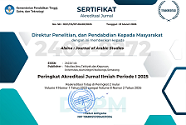The Challenges of Learning Arabic Listening Skills Using Youtube as a Learning Tool
DOI:
https://doi.org/10.21580/alsina.6.2.23369Keywords:
Arabic listening skills, challenges in learning Arabic, youtube learning mediaAbstract
This study investigates the challenges encountered in learning mahārat al-istimāʿ (listening skills) through using YouTube as a supplementary learning tool. Employing a quantitative approach with a survey design, the research gathered data on students’ experiences and perceptions regarding the integration of YouTube in Arabic listening instruction. The findings indicate several obstacles, such as rapid native speech, unclear dialogues, unfamiliar vocabulary, auditory processing difficulties, limited comprehension, and reduced concentration. The study also highlights the psychological effects and motivational responses associated with using this platform. Despite these challenges, YouTube demonstrates significant potential as a rich and accessible resource for enhancing listening skills. The study recommends improving content accessibility, applying stricter content selection, and integrating guided learning strategies to support a more effective and engaging learning environment.
Downloads
References
Adams, Harlen M. “Learning to Listen.” The Clearing House: A Journal of Educational Strategies, Issues and Ideas 20, no. 7 (1946): 401–3. https://doi.org/10.1080/00098655.1946.11473767.
Azor, Richard Ojinnakaeze et al. “YouTube Audio-Visual Documentaries: Effect on Nigeria Students’ Achievement and Interest in History Curriculum.” The Journal of Educational Research 113, no. 5 (2020): 317–26. https://doi.org/10.1080/00220671.2020.1819182.
Boltiziar, Jana, and Dasa Munkova. “Emergency Remote Teaching of Listening Comprehension Using YouTube Videos with Captions.” Education and Information Technologies 29, no. 9 (2024): 11367–83. https://doi.org/10.1007/s10639-023-12282-7.
Hamidah, Hamidah. “Arabic Language: Between Learning Necessity and Responsibility (Ar).” Al-Ta’rib : Jurnal Ilmiah Program Studi Pendidikan Bahasa Arab IAIN Palangka Raya 7, no. 1 (2019): 35–44. https://doi.org/10.23971/altarib.v7i1.1472.
Hamidah, Hamidah, and Marsiah Marsiah. “Pembelajaran Maharah Al-Istima’ dengan Memanfaatkan Media Youtube: Problematika dan Solusi.” Al-Ta’rib : Jurnal Ilmiah Program Studi Pendidikan Bahasa Arab IAIN Palangka Raya 8, no. 2 (2020): 147–60. https://doi.org/10.23971/altarib.v8i2.2282.
Hermawan, Acep. Metodologi Pembelajaran Bahasa Arab. Bandung: Remaja Rosdakarya, 2011.
Hsieh, Yufen. “Effects of Video Captioning on EFL Vocabulary Learning and Listening Comprehension.” Computer Assisted Language Learning 33, no. 5–6 (2020): 567–89. https://doi.org/10.1080/09588221.2019.1577898.
Jones, Troy, and Kristen Cuthrell. YouTube: Educational Potentials and Pitfalls. Computers in the Schools. Vol. 28, 2011. https://doi.org/10.1080/07380569.2011.553149.
Jubaidah, Siti et al. “Fa’āliyyah Ta’līm Mahārah Al-Istimā’ Bi Istikhdām Android Li Al-Jawwāl.” LISANIA: Journal of Arabic Education and Literature 4, no. 1 (2020): 49–64. https://doi.org/10.18326/lisania.v4i1.49-64.
Julaikah, Dwi Imroatu. “Menghadirkan Film dalam Pembelajaran Bahasa Jerman sebagai Bahasa Asing (Deutsch Als Fremdsprache).” Paramasastra 4, no. 1 (2017): 119–27. https://doi.org/10.26740/parama.v4i1.1487.
Lestari, Sri Indah et al. “Penerapan Metode Audiolingual dalam Pembelajaran Keterampilan Menyimak Bahasa Arab secara Daring: Studi Kasus di SMPIT Adzkia Padang.” Alsina : Journal of Arabic Studies 6, no. 1 (2024): 27–46. https://doi.org/10.21580/alsina.6.1.23100.
Mahalingappa, Laura et al. “The Impact of Captioning and Playback Speed on Listening Comprehension of Multilingual English Learners at Varying Proficiency Levels.” System 120 (2024): 103192. https://doi.org/10.1016/j.system.2023.103192.
Makruf, Imam. “Pemanfaatan Teknologi Informasi dan Komunikasi dalam Pembelajaran Bahasa Arab di Madrasah Aliyah Kabupaten Sukoharjo.” Arabi : Journal of Arabic Studies 5, no. 1 (2020): 79–90. https://doi.org/10.24865/ajas.v5i1.93.
Marchant, G. C. “The Efficiency of Film in Education.” Educational Media International 11, no. 1 (1974): 11–12. https://doi.org/10.1080/09523987408548696.
Mochammad, Putra Bagus, and Wiaam Mohammad Syairozi. “Istiratijiyat Talamidz Al-Marhalah Al-Tsanawiyah Bi Ma’Had Darussalam Gontor Fi Ta’Allum Maharah Al-Kitabah.” Arabiyat : Jurnal Pendidikan Bahasa Arab Dan Kebahasaaraban 4, no. 1 (2017): 102–11. https://doi.org/10.15408/a.v4i1.5329.
Moghavvemi, Sedigheh et al. “Social Media as a Complementary Learning Tool for Teaching and Learning: The Case of Youtube.” The International Journal of Management Education 16, no. 1 (March 2018): 37–42. https://doi.org/10.1016/j.ijme.2017.12.001.
Mubarak, Mahfuz Rizqi et al. “Penggunaan Vlog dalam Pembelajaran Mahārah Kalām.” Al Mi’yar: Jurnal Ilmiah Pembelajaran Bahasa Arab dan Kebahasaaraban 3, no. 1 (2020): 109–26. https://doi.org/10.35931/am.v3i1.209.
Muradi, Ahmad, and Hasbullah Hasbullah. “Strategi Belajar Bahasa Arab Mahasiswa Prodi PBA IAIN Antasari Banjarmasin Menurut Model Oxford.” LiNGUA: Jurnal Ilmu Bahasa dan Sastra 11, no. 1 (2016): 54–62. https://doi.org/10.18860/ling.v11i1.3413.
Nasution, Nur Padilah. “Nahwu Learning at Darul Ikhlas Islamic Boarding School Mandailing Natal.” Lisaanuna Ta`lim Al-Lughah Al-Arabiyah: Jurnal Pendidikan Bahasa Arab 5, no. 1 (2022): 70–83. https://doi.org/10.15548/lisaanuna.v5i1.3837.
Nuha, Ulin. Ragam Metodologi dan Media Pembelajaran Bahasa Arab. Yogyakarta: DIVA Press, 2016.
Nuraeny, Yeny. “Strategi Mengatasi Kesulitan Belajar Bahasa Arab Peserta Didik pada Mata Kuliah Istima’i.” Alashriyyah 2, no. 1 (2016): 117–28. https://doi.org/10.53038/alashriyyah.v2i1.15.
Shaojie, Tan et al. “Systematic Literature Review on Audio-Visual Multimodal Input in Listening Comprehension.” Frontiers in Psychology 13 (2022). https://doi.org/10.3389/fpsyg.2022.980133.
Tamim, Rana M. “Teachers’ Use of YouTube in the United Arab Emirates: An Exploratory Study.” Computers in the Schools 30, no. 4 (2013): 329–45. https://doi.org/10.1080/07380569.2013.844641.
Ṭuʻaymah, Rushdī Aḥmad. Al-Marjaʿ Fī Taʿlīm Al-Lughah Al-ʿArabīyah Li-Al-Nāṭiqīn Bi-Lughāt Ukhrá. Mecca: Jāmiʿat Umm al-Qurá, 1986.
Wang, Hung-chun, and Cheryl Wei-yu Chen. “Learning English from YouTubers: English L2 learners’ self-regulated language learning on YouTube.” Innovation in Language Learning and Teaching 14, no. 4 (2020): 333–46. https://doi.org/10.1080/17501229.2019.1607356.
Zainuddin, Radliyah. Metodologi dan Strategi Alternatif Pembelajaran Bahasa Arab. Jakarta: Pustaka Rihlah Group, 2005.
Downloads
Published
How to Cite
Issue
Section
License
Copyright (c) 2024 Alsina : Journal of Arabic Studies

This work is licensed under a Creative Commons Attribution-NonCommercial-ShareAlike 4.0 International License.
Copyright
The copyright of the received article shall be assigned to the publisher of the journal. The intended copyright includes the right to publish the article in various forms (including reprints). The journal maintains the publishing rights to published articles. Authors are allowed to use their articles for any legal purposes deemed necessary without written permission from the journal, but with an acknowledgment to this journal of initial publication.
Licensing
In order for Alsina: Journal of Arabic Studies to publish and distribute research articles, the editors need publishing rights (transferred from author to publisher). This agreement relates to the transfer/publishing copyright license to Alsina: Journal of Arabic Studies but the authors still have significant rights to use and share their published articles.
Alsina: Journal of Arabic Studies supports the need for writers to share, disseminate and maximize the impact of their research and their rights on any database. As a journal article writer, you have the right to various uses of your articles, including that by the institution or company where you work. Copyright can be used without the need for special permission. Authors who publish articles in the Alsina: Journal of Arabic Studies have broad rights to use their work for teaching and scientific purposes without requesting permission, including:
- Use by the author for lectures, presentations, or conferences, with distribution of copies to participants;
- Distribution to colleagues for research use;
- Use in compilations of the author's subsequent work;
- inclusion in a thesis or dissertation;
- Reuse of sections or excerpts from articles in other works (with full acknowledgment of the final article);
- Preparation of derivative works (other than commercial purposes) (with full acknowledgment of the final article);
- Voluntary posting on open websites operated by authors’ or writers' agencies for scientific purposes
When submitting a manuscript, authors do so on the understanding that if accepted for publication, the copyright for publishing (publishing right) of the article shall be assigned/transferred to Alsina: Journal of Arabic Studies.
Authors whose articles are accepted for publication will receive confirmation via email and sent a Copyright Transfer Agreement.

 Accreditation
Accreditation 
 In Collaboration with
In Collaboration with 

 Visitors
Visitors  Article Template
Article Template





